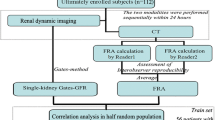Abstract
A spherical bladder dynamic model for the estimates of the radiation dose to the bladder walls from intravenously injected radionuclides was implemented to investigate in theory the effect of hydration on the reduction of the bladder dose in technetium-99m diethylene triamine penta-acetic acid (99mTc) DTPA renography. This model gives due consideration to the variation with time of the urine flow rate to the bladder, following a known fluid load. According to the model, the estimated dose depends on the renal function, the fluid load, the time elapsed from the fluid load to the i.v. DTPA injection, the micturition volume and the residual urine volume. Experimental data concerning the values of these parameters for normal individuals were obtained from the literature. Calculations cover the time period from i.v. injection up to the time of the ninth postinjection void. Results show that the patient's condition of hydration is critical for the radiation protection of the bladder. It is shown that optimum combinations of the values of the parameters involved in the calculations exist, which minimize the radiation dose. On the basis of these results, a general protocol is proposed, referring to the hydration conditions under which the renal dynamic study may be normally carried out, with a minimal absorbed dose to the bladder walls (<0.045 mGy/MBq).
Similar content being viewed by others
References
Berger MJ (1968) Energy deposition in water by photons from point isotropic sources. (MIRD pamphlet no 2) J Nucl Med 9 [Suppl 1]:19
Diem K (ed) (1962) Scientific tables. (Documenta Geigy) J.R. Geigy, Basle, p 527
Diffey B, Hilson A (1976) Absorbed dose to the bladder from 99mTc-DTPA. Br J Radiol 49:197–198
Dilman LT (1969) Radionuclide decay schemes and nuclear parameters for use in radiation-dose estimation, (MIRD pamphlet 4) Society of Nuclear Medicine, New York
Dowd MT, Chen CT, Wendel MJ, Faulhaber PJ, Cooper MD (1991) Radiation dose to the bladder wall from 2-18F] fluoro2-deoxy-d-glucose in adult humans. J Nucl Med 32:707–712
Gill WB, Curtis GA (1977) The influence of bladder fulness on upper urinary tract dimensions and renal excretory function. J Urol 117:573–575
Haylen BT (1989) Residual urine volumes in a normal femal population: Application of transvaginal ultrasound. Br J Urol 64:347–349
Haylen BT, Frazer MI, Sutherst JR, Ashby D (1989) The accuracy of measurement of residual urine in women by urethral catheterisation. Br J Urol 63:152–154
ICRP (1987) Publication 53. Radiation dose to patients from radiopharmaceuticals. Pergamon Press, Oxford 18:1.4, p 43
Morgan KZ, Emerson LC (1967) Dose from external sources of radiation. In: Morgan KJ, Turner JE (eds) Principles of radiation protection. Wiley, New York London Sydney, p 285
Muellner S (1960) Development of urinary control in children. JAMA 172:120–125
Poulsen EU, Kirkeby HJ (1988) Home monitoring of uroflow in normal male adolescents: relation between flow-curve, voided volume and time of day. Scand J Urol Nephrol Suppl 114:58–62
Snyder WS (1970) Medical radionuclides: radiation dose and effects. (AEC Symp Series no 20) United States Atomic Energy Commission, Oak ridge
Thomas SR, Stabin MG, Chen CT, Poston JW (1988) Urinary bladder model for radiation dosimetry calculations. A realistic approach (abstract 557). J Nucl Med 29:875
Unnikrishnan K (1974) Dose to the urinary bladder from radionuclides in urine. Phys Med Biol 19:329–340
Zwiers W, Driel MF, Ruiter BJ, Beekhuis H, Piers A, Jonge MC (1987) Radionuclide renography to evaluate urodynamically expected upper tract obstructions in patients with meningomyelocele. J Urol 138:385–386
Author information
Authors and Affiliations
Additional information
Offprint requests to: P. Dimitriou
Rights and permissions
About this article
Cite this article
Dimitriou, P.A., Tsinikas, D.T., Depaskouale, A.K. et al. The effect of hydration on the dose to the urinary bladder wall during technetium-99m diethylene triamine penta-acetic acid renography. Eur J Nucl Med 19, 765–769 (1992). https://doi.org/10.1007/BF00182817
Received:
Revised:
Issue Date:
DOI: https://doi.org/10.1007/BF00182817




